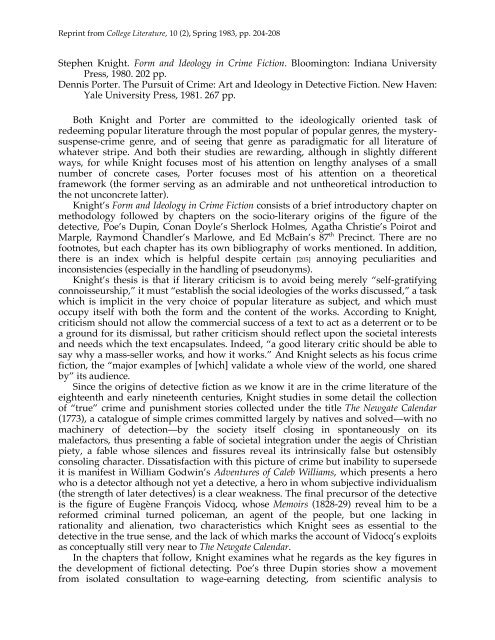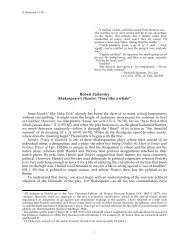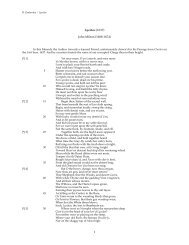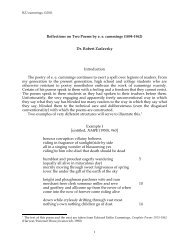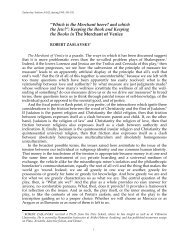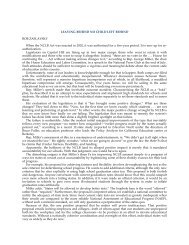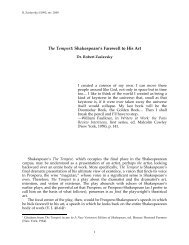Stephen Knight. Form and Ideology in Crime Fiction. Bloomington ...
Stephen Knight. Form and Ideology in Crime Fiction. Bloomington ...
Stephen Knight. Form and Ideology in Crime Fiction. Bloomington ...
You also want an ePaper? Increase the reach of your titles
YUMPU automatically turns print PDFs into web optimized ePapers that Google loves.
Repr<strong>in</strong>t from College Literature, 10 (2), Spr<strong>in</strong>g 1983, pp. 204-208<strong>Stephen</strong> <strong>Knight</strong>. <strong>Form</strong> <strong>and</strong> <strong>Ideology</strong> <strong>in</strong> <strong>Crime</strong> <strong>Fiction</strong>. Bloom<strong>in</strong>gton: Indiana UniversityPress, 1980. 202 pp.Dennis Porter. The Pursuit of <strong>Crime</strong>: Art <strong>and</strong> <strong>Ideology</strong> <strong>in</strong> Detective <strong>Fiction</strong>. New Haven:Yale University Press, 1981. 267 pp.Both <strong>Knight</strong> <strong>and</strong> Porter are committed to the ideologically oriented task ofredeem<strong>in</strong>g popular literature through the most popular of popular genres, the mysterysuspense-crimegenre, <strong>and</strong> of see<strong>in</strong>g that genre as paradigmatic for all literature ofwhatever stripe. And both their studies are reward<strong>in</strong>g, although <strong>in</strong> slightly differentways, for while <strong>Knight</strong> focuses most of his attention on lengthy analyses of a smallnumber of concrete cases, Porter focuses most of his attention on a theoreticalframework (the former serv<strong>in</strong>g as an admirable <strong>and</strong> not untheoretical <strong>in</strong>troduction tothe not unconcrete latter).<strong>Knight</strong>’s <strong>Form</strong> <strong>and</strong> <strong>Ideology</strong> <strong>in</strong> <strong>Crime</strong> <strong>Fiction</strong> consists of a brief <strong>in</strong>troductory chapter onmethodology followed by chapters on the socio-literary orig<strong>in</strong>s of the figure of thedetective, Poe’s Dup<strong>in</strong>, Conan Doyle’s Sherlock Holmes, Agatha Christie’s Poirot <strong>and</strong>Marple, Raymond Ch<strong>and</strong>ler’s Marlowe, <strong>and</strong> Ed McBa<strong>in</strong>’s 87 th Prec<strong>in</strong>ct. There are nofootnotes, but each chapter has its own bibliography of works mentioned. In addition,there is an <strong>in</strong>dex which is helpful despite certa<strong>in</strong> [205] annoy<strong>in</strong>g peculiarities <strong>and</strong><strong>in</strong>consistencies (especially <strong>in</strong> the h<strong>and</strong>l<strong>in</strong>g of pseudonyms).<strong>Knight</strong>’s thesis is that if literary criticism is to avoid be<strong>in</strong>g merely “self-gratify<strong>in</strong>gconnoisseurship,” it must “establish the social ideologies of the works discussed,” a taskwhich is implicit <strong>in</strong> the very choice of popular literature as subject, <strong>and</strong> which mustoccupy itself with both the form <strong>and</strong> the content of the works. Accord<strong>in</strong>g to <strong>Knight</strong>,criticism should not allow the commercial success of a text to act as a deterrent or to bea ground for its dismissal, but rather criticism should reflect upon the societal <strong>in</strong>terests<strong>and</strong> needs which the text encapsulates. Indeed, “a good literary critic should be able tosay why a mass-seller works, <strong>and</strong> how it works.” And <strong>Knight</strong> selects as his focus crimefiction, the “major examples of [which] validate a whole view of the world, one sharedby” its audience.S<strong>in</strong>ce the orig<strong>in</strong>s of detective fiction as we know it are <strong>in</strong> the crime literature of theeighteenth <strong>and</strong> early n<strong>in</strong>eteenth centuries, <strong>Knight</strong> studies <strong>in</strong> some detail the collectionof “true” crime <strong>and</strong> punishment stories collected under the title The Newgate Calendar(1773), a catalogue of simple crimes committed largely by natives <strong>and</strong> solved—with nomach<strong>in</strong>ery of detection—by the society itself clos<strong>in</strong>g <strong>in</strong> spontaneously on itsmalefactors, thus present<strong>in</strong>g a fable of societal <strong>in</strong>tegration under the aegis of Christianpiety, a fable whose silences <strong>and</strong> fissures reveal its <strong>in</strong>tr<strong>in</strong>sically false but ostensiblyconsol<strong>in</strong>g character. Dissatisfaction with this picture of crime but <strong>in</strong>ability to supersedeit is manifest <strong>in</strong> William Godw<strong>in</strong>’s Adventures of Caleb Williams, which presents a herowho is a detector although not yet a detective, a hero <strong>in</strong> whom subjective <strong>in</strong>dividualism(the strength of later detectives) is a clear weakness. The f<strong>in</strong>al precursor of the detectiveis the figure of Eugène François Vidocq, whose Memoirs (1828-29) reveal him to be areformed crim<strong>in</strong>al turned policeman, an agent of the people, but one lack<strong>in</strong>g <strong>in</strong>rationality <strong>and</strong> alienation, two characteristics which <strong>Knight</strong> sees as essential to thedetective <strong>in</strong> the true sense, <strong>and</strong> the lack of which marks the account of Vidocq’s exploitsas conceptually still very near to The Newgate Calendar.In the chapters that follow, <strong>Knight</strong> exam<strong>in</strong>es what he regards as the key figures <strong>in</strong>the development of fictional detect<strong>in</strong>g. Poe’s three Dup<strong>in</strong> stories show a movementfrom isolated consultation to wage-earn<strong>in</strong>g detect<strong>in</strong>g, from scientific analysis to
Repr<strong>in</strong>t from College Literature, 10 (2), Spr<strong>in</strong>g 1983, pp. 204-208oracular <strong>in</strong>sight, from realism to romanticism, from withdrawn cerebration toexternalized self-awareness (as represented by Dup<strong>in</strong>’s encounter with his double, D.);<strong>in</strong> short, they “together imply that the isolated <strong>in</strong>tellectual <strong>and</strong> imag<strong>in</strong>ative life is asufficient <strong>and</strong> successful response to the world” <strong>and</strong> is a marketable commodity for thehuman good, a vision which validates “the ideology of the bourgeois professional<strong>in</strong>telligentsia.” Of course, Sherlock Holmes is the detective, through whom Conan Doyle“domesticates” the tw<strong>in</strong> notions of positive scientific necessary causality <strong>and</strong> the<strong>in</strong>dividual’s power to discern that causality: “Doyle’s ability to popularize <strong>and</strong>naturalize rational <strong>in</strong>dividualism runs through the stories <strong>and</strong> is central to theirsuccess.” Holmes is the heroic apotheosis of bourgeois professionalism, fus<strong>in</strong>g amaterialistic view of the world, a pervasive egalitarianism (with its correspond<strong>in</strong>gdisda<strong>in</strong> for aristocracy), <strong>and</strong> a view of crime—at least <strong>in</strong> the most popular shortstories—as petty <strong>and</strong> unthreaten<strong>in</strong>g. Agatha Christie presents a new level of [206]bourgeois self-consciousness through the clue-puzzle structure of her writ<strong>in</strong>g <strong>and</strong> theelevation of the bourgeois woman as a force for the restoration of societal order: bothPoirot <strong>and</strong> Marple are def<strong>in</strong>ed by stereotypically female characteristics.In all of this, <strong>Knight</strong>’s analysis is frequently acute, but too often the writ<strong>in</strong>g seemslabored. It is only when he turns to Ch<strong>and</strong>ler <strong>and</strong> McBa<strong>in</strong> that the book <strong>and</strong> the writ<strong>in</strong>gseem to come alive. Indeed, except for certa<strong>in</strong> passages <strong>in</strong> the discussion of Holmes, thesequence of historical <strong>and</strong> British chapters has the feel of an obligation, a pay<strong>in</strong>g of duesto entitle him to step at last onto what he regards as his terra firma, the Americanhardboiled novel.In the discussion of Ch<strong>and</strong>ler, <strong>Knight</strong> tell<strong>in</strong>gly shows how the ostensible objectivity<strong>and</strong> naturalism of the style are <strong>in</strong> reality a black mask for a subjective romanticism.Marlowe as the narrator is a central controll<strong>in</strong>g consciousness with respect to whicheveryth<strong>in</strong>g else is def<strong>in</strong>ed. “The mixture of an apparently open <strong>and</strong> modernisttechnique <strong>and</strong> an actually authoritarian romantic core . . . is a powerful <strong>and</strong> successfulillusion, appeal<strong>in</strong>g directly to an audience for whom the pull of romanticism was greatbut for whom its characteristic n<strong>in</strong>eteenth century formulation was no longer a viablemedium of response.” And <strong>Knight</strong> sees Ch<strong>and</strong>ler’s idealist form <strong>and</strong> his presentation ofthe <strong>in</strong>formed <strong>and</strong> self-defend<strong>in</strong>g alienated <strong>in</strong>dividual as a real advance over hispredecessors. It is the elevation of the moral value of the <strong>in</strong>dividual <strong>and</strong> the denigrationof the external collective <strong>and</strong> mechanistic world. Its only defect is that it deliberatelyevades “the realities of urban crime.”The police procedural story, a post-WW II sub-genre, is meant to remedy this defect<strong>and</strong> was formulated <strong>in</strong> response to the media-sophisticated <strong>and</strong> hence better <strong>in</strong>formedaudience which dem<strong>and</strong>ed greater verisimilitude <strong>in</strong> its crime fiction. Its most prolific<strong>and</strong> popular practitioners are the Englishman John Creasey (under the pseudonym “J. J.Marric”), with his Comm<strong>and</strong>er George Gideon of Scotl<strong>and</strong> Yard novels set <strong>in</strong> London,<strong>and</strong> the American Ed McBa<strong>in</strong> (pseudonym of Evan Hunter), with his 87 th Prec<strong>in</strong>ctnovels set <strong>in</strong> Isola (a th<strong>in</strong>ly disguised Manhattan). McBa<strong>in</strong>’s goal is to “create pragmaticliberal humanist fables about crime, the police <strong>and</strong> the city” employ<strong>in</strong>g a “quasiobjectivemode” bolstered by documentary <strong>in</strong>serts to <strong>in</strong>crease the sense ofverisimilitude. In this way, McBa<strong>in</strong> presents a mechanistic view of people together withits necessary concomitant, a liberal humanist ideology: “<strong>in</strong> the dual, self-contradictorypatterns of his novels, McBa<strong>in</strong> creates an illusion of security, enabl<strong>in</strong>g his readers to feelthat a human protective quality is still present <strong>in</strong> the oppressive modern reality of themechanical world of commodities.” <strong>Knight</strong>’s book, then, is an admirable beg<strong>in</strong>n<strong>in</strong>g to astudy of the sociology of detective fiction, <strong>and</strong> as such it whets one’s appetite for a morecomprehensive approach.
Repr<strong>in</strong>t from College Literature, 10 (2), Spr<strong>in</strong>g 1983, pp. 204-208Such an approach is found <strong>in</strong> Dennis Porter’s The Pursuit of <strong>Crime</strong>, an exercise <strong>in</strong>what he calls metasleuth<strong>in</strong>g. The Pursuit of <strong>Crime</strong> consists of a brief <strong>in</strong>troduction; fivechapters <strong>in</strong> Part I on the art (i.e., formal characteristics) of crime literature, suspense,textual readability, <strong>and</strong> narrative erotics; six chapters <strong>in</strong> Part II on the ideology of thegenre, focus<strong>in</strong>g on the detective hero <strong>and</strong> the language, l<strong>and</strong>scape, <strong>and</strong> formulaic natureof detection; <strong>and</strong> two chapters <strong>in</strong> Part III on the pleasures of detective fiction <strong>and</strong> onmodernist anti-detective fiction. It also conta<strong>in</strong>s a useful <strong>in</strong>dex[207]In the <strong>in</strong>troduction, Porter asserts that “perhaps the most compell<strong>in</strong>g reason forpay<strong>in</strong>g attention to popular literature is its popularity,” <strong>and</strong> asks what he calls theclassic question: “Why, at a time when so much solicits the attention, do great numbersof people still choose to read tales of crime <strong>and</strong> detection, if they read any books at all?”He argues that s<strong>in</strong>ce the formulaic component of all literature has been revealed bycurrent critical trends, no text can be ignored simply because it is formulaic. Nor is analleged escapism a valid ground for disregard, because “the <strong>in</strong>terest<strong>in</strong>g question that isoften begged . . . is why people bother to escape <strong>in</strong>to literature at all, if that is what theyare, <strong>in</strong> fact, do<strong>in</strong>g.” In addition, the analysis of detective fiction illum<strong>in</strong>ates the activityof novel read<strong>in</strong>g <strong>in</strong> general, impels one to face the question of ideology, <strong>and</strong> dem<strong>and</strong>s areader-centered approach.Porter beg<strong>in</strong>s with a survey of the major crime literature prior to Poe, <strong>and</strong> hementions that there are some who trace its roots back even to antiquity.Here I must mention a regrettable bl<strong>in</strong>d spot <strong>in</strong> an otherwise f<strong>in</strong>e book, namelyPorter’s failure to cite the work of Dorothy L. Sayers where it would be appropriate. Inhis first footnote, he cites a French work of 1965 <strong>and</strong> fails to mention The Omnibus of<strong>Crime</strong>, ed. Sayers, published <strong>in</strong> 1929, which <strong>in</strong>cludes tales of detection from HerodotusII, the Apocrypha Book of Daniel, <strong>and</strong> Aeneid VIII. In the second chapter (pp. 31 ff.),when he discusses the formal characteristics of the detective novel <strong>in</strong> terms ofAristotle’s Poetics, he aga<strong>in</strong> fails to cite Sayers, <strong>in</strong> this case her 1935 lecture “Aristotle onDetective <strong>Fiction</strong>.”Porter <strong>in</strong>troduces his survey by sketch<strong>in</strong>g the dist<strong>in</strong>ction between the ancientprimacy of the mythic-sacred crime <strong>and</strong> the primacy of profane crime <strong>in</strong> thedesacralized modern world, although both types have been co-present through allhuman history. He exam<strong>in</strong>es the picaresque <strong>and</strong> ephemeral literature of the eighteenthcentury, Godw<strong>in</strong>’s Caleb Williams, Hugo <strong>and</strong> Dickens, the memoirs of crime fighterssuch as Vidocq, the sensation novels <strong>and</strong> the romans feuilletons. He concludes with abrief discussion of DeQu<strong>in</strong>cey’s sem<strong>in</strong>al essay, “On Murder Considered as One of theF<strong>in</strong>e Arts,” show<strong>in</strong>g how this sets the stage for the advent of “the Great Detective”:“Poe <strong>in</strong>vented the f<strong>in</strong>e art of detection as a counterpart to the f<strong>in</strong>e art of murder.”In the second chapter, the discussion of Poe as a historical culm<strong>in</strong>ation transformsitself <strong>in</strong>to a structural analysis of the genre as a whole, <strong>in</strong> particular the pr<strong>in</strong>ciple ofbackward construction, <strong>in</strong> which the denouement is legislative for all the narrative unitswhich precede it. With Dup<strong>in</strong>—the artist-detective amateur of genius, the fusion ofgothicism <strong>and</strong> ratioc<strong>in</strong>ation—Poe demonstrated his mastery of the narrative techniqueof suspense which operates more or less <strong>in</strong> all narratives, a displacement ofchronological time which must be logico-temporally restored <strong>and</strong> retardedsimultaneously. Porter applies his <strong>in</strong>sights to Wilkie Coll<strong>in</strong>s’ The Moonstone, ConanDoyle’s The Hound of the Baskervilles, <strong>and</strong> Raymond Ch<strong>and</strong>ler’s The Big Sleep, each ofwhich “illustrates the apparent paradox that the progressive <strong>and</strong> digressive units of anarrative sequence are often one <strong>and</strong> the same.” The next chapter explores the role of
Repr<strong>in</strong>t from College Literature, 10 (2), Spr<strong>in</strong>g 1983, pp. 204-208digressions <strong>in</strong> creat<strong>in</strong>g suspense <strong>and</strong> here the discussion exp<strong>and</strong>s to <strong>in</strong>clude novels offoreign scene <strong>and</strong> <strong>in</strong>ternational scope, such as those of Simenon, Freel<strong>in</strong>g, <strong>and</strong> Flem<strong>in</strong>g.[208]Of course, the detective novel possesses readability par excellence, comb<strong>in</strong><strong>in</strong>g as noother form does both pleasure <strong>and</strong> <strong>in</strong>telligibility. One of the important aspects of thegenre’s readability, which is exemplified <strong>in</strong> the narrative of “Goldilocks <strong>and</strong> the ThreeBears,” is its dejà vu quality, the sense <strong>in</strong> which the read<strong>in</strong>g of it is always a re-read<strong>in</strong>g.(It is <strong>in</strong> this fourth chapter that another unfortunate lapse of scholarship occurs, <strong>in</strong>which S. S. Van D<strong>in</strong>e is cited <strong>in</strong> footnote 4 as the author of “the Detective Club Rules.”The Club is actually the London Detection Club, of which the American Van D<strong>in</strong>e wasnot a member, <strong>and</strong> its oath is different from his twenty rules.)The second part of Porter’s study focuses on ideology. Here the verisimilitud<strong>in</strong>ouscharacter of detective fiction, its ties to the realist tradition, its fidelity to contemporarysocial reality, <strong>and</strong> its effacement of its character as text all come <strong>in</strong>to play. And aga<strong>in</strong>, as<strong>in</strong> <strong>Knight</strong>, the keys are the textual silences <strong>and</strong> fissures, only discernible through anunderst<strong>and</strong><strong>in</strong>g of the socio-history of crime <strong>and</strong> punishment. And the ideologicalcontent which thus comes to sight is primarily <strong>and</strong> for the most part conservative: “it is<strong>in</strong> conformity with the most cherished behavioral norms of a given society.” The mostperfect language of detection, it seems, is the language of Ch<strong>and</strong>ler, a mythic stylizationof qu<strong>in</strong>tessential American values which is a reaction to the tawdr<strong>in</strong>ess of Americanlife.Next Porter returns to the beg<strong>in</strong>n<strong>in</strong>g <strong>and</strong> traces the history of the mach<strong>in</strong>ery ofdetection <strong>and</strong> the detective, the emergence of which was a consequence of the political<strong>and</strong> <strong>in</strong>dustrial revolution of the late eighteenth <strong>and</strong> n<strong>in</strong>eteenth centuries. He follows,then, the fictional detective from Inspector Bucket <strong>and</strong> Sergeant Cuff to Mike Hammer<strong>and</strong> James Bond. And this is followed by a consideration of the urban l<strong>and</strong>scape with<strong>in</strong>which the detective most typically moves, where Simenon’s Maigret shows that this isnot merely an Anglo-American phenomenon. Porter concludes his argument with theassertion that “detective novels provide reassurance, not only because they deal <strong>in</strong>identifiable good <strong>and</strong> evil <strong>and</strong> end up punish<strong>in</strong>g the latter but also because theypropose a world of fixed cultural quantities.”The third part of Porter’s study is entitled “Beyond Detection.” First, he elaboratesMarjorie Nicolson’s reflections on the academicist love of the mystery genre. Second, heexam<strong>in</strong>es works which he calls anti-detective, works which deliberately thwart therhythm of desire that is satisfied so well <strong>in</strong> detective fiction, works by Henry James,Kafka, Robbe-Grillet, <strong>and</strong> Borges. This foray <strong>in</strong>to so-called ma<strong>in</strong>stream literature ismore a program than a completed project.Both <strong>Knight</strong> <strong>and</strong> Porter, then, have gone a long way toward provid<strong>in</strong>g a basis forstudy<strong>in</strong>g the ideology of the mystery genre. Despite the fact that they both commitwhat used to be regarded as the card<strong>in</strong>al mystery fiction critic crime, namely reveal<strong>in</strong>gthe end<strong>in</strong>gs of the books that they discuss, <strong>Knight</strong>’s <strong>and</strong> Porter’s two studies areworthwhile, <strong>in</strong>formative, thoughtful. They are thorough critical quests which willencourage readers who have not yet succumbed to the mystery fiction compulsion tosuccumb (or at least not to scorn those who have) <strong>and</strong> will reward <strong>and</strong> enlighten thoseas addicted to the genre as I am.Robert ZaslavskyBryn Mawr College


